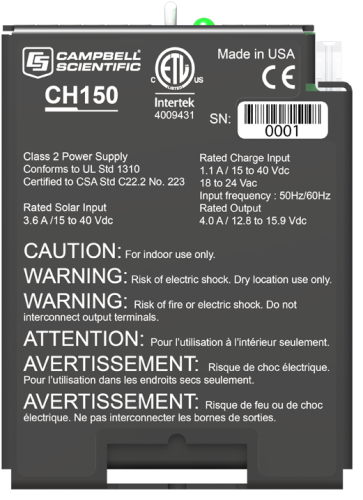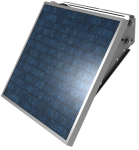
動画とチュートリアル
ドキュメント
よくある質問
電源に関するよくある質問の数: 4
すべて展開すべて折りたたむ
-
バッテリが約 10 または 8 V 以上に充電されない場合は、セルが不良です。バッテリを交換する必要があります。
12 V 鉛蓄電池は 6 つのセルが直列に接続されており、化学的性質によりセルあたり 2 V を少し超える電圧が供給されます。
-
はい。ただし、充電式ベース付きの CR3000 など、データロガーに充電式バッテリが内蔵されている場合は、バイクのバッテリをデータロガー前面の緑色の電源コネクタに接続する前に、データロガーのバッテリを外してください。Ahr 定格が異なる 2 つの充電式バッテリを並列に接続しないでください。
-
電源の種類を選択する前に、まず対象期間の電力予算を計算する必要があります。たとえば、静止モードの CR1000 は約 0.7 mA を消費します。静止電流とは、データロガーが測定を行っておらず、何とも通信していないことを意味します。また、年間のこの電流消費には、計算に含めるべきセンサや通信デバイスによって消費される電流は含まれていません。これは、1 日あたり 0.0168 A、または 1 年あたり 6.132 A に相当します。
通常、どのバッテリ方式でも予備容量の 20% のバッファを保持する必要があります。これは年間約 7.7 A に相当します。気温が氷点下のアプリケーションでは、Campbell Scientific は予備電流を 30 ~ 40% に増やすことを推奨しています。
この量の電流を蓄えることは、BPALK 12-V アルカリ電池パックや、PS100 充電式電源で使用されるような 7 Ah 電池では不可能です。より適切な選択肢は、BP12 12 Ah 電池パック、BP24 24 Ah 電池パック、PS84 84 Ah 電源、BP84 84 Ah 電池パック、またはユーザー提供のディープサイクル電池です。電池は、使用期間の終わりごとに交換して充電できます。
-
Privacy Policy Update
We've updated our privacy policy. 詳細はこちら
Cookie Consent
Update your cookie preferences. クッキーの設定を更新する




